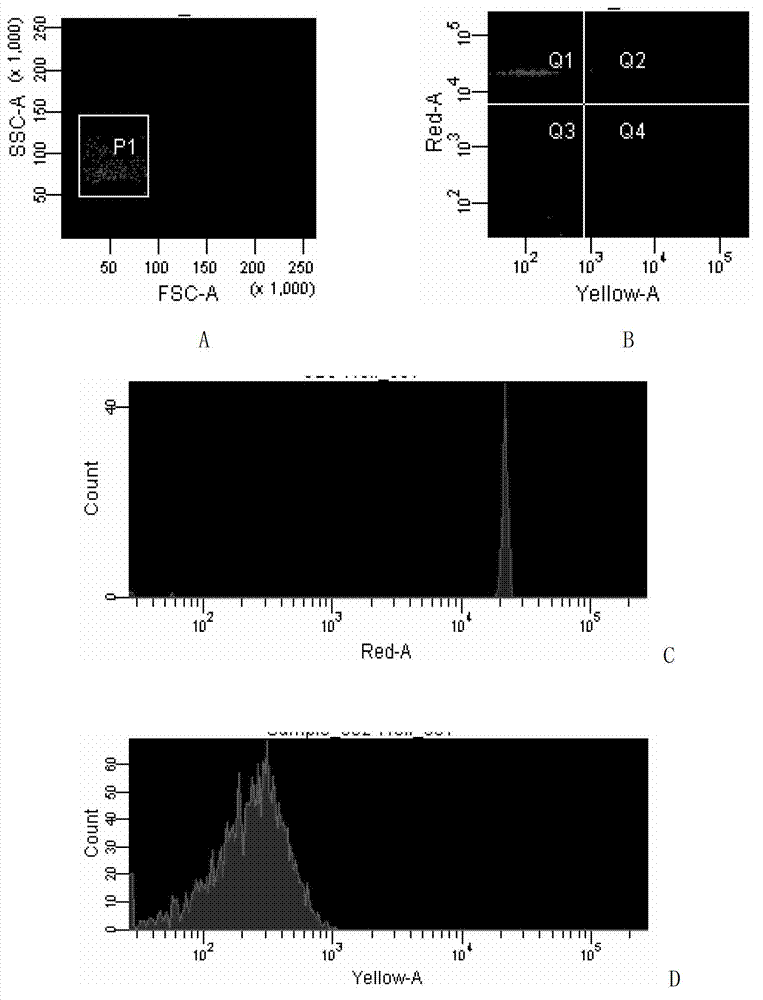Method for detecting shrimp white spot disease virus based on liquid chip
A technology for white spot disease and virus of prawns, applied in biochemical equipment and methods, microbe measurement/inspection, DNA/RNA fragments, etc., can solve problems such as unsuitable for a large number of sample detection, harmful to human body and environment, and cumbersome methods, etc. Achieve the effects of short time required, high sensitivity, and no environmental pollution
- Summary
- Abstract
- Description
- Claims
- Application Information
AI Technical Summary
Problems solved by technology
Method used
Image
Examples
Embodiment 1
[0037] Embodiment 1, the design of specific primer pair and specific probe
[0038] Through a large number of sequence alignments and comparisons of amplification effects, a specific primer pair and a specific probe for amplifying shrimp white spot disease virus were designed.
[0039]The specific primer pair is as follows (the target sequence is 232bp):
[0040] F1 (sequence 1 of the sequence listing): 5'-CCGCAATGGAAAGTCTGA-3';
[0041] R1 (SEQ ID NO: 2 of the Sequence Listing): 5'-GGTGAAGGAGGAGGTGTT-3'.
[0042] The nucleotide sequence of the specific probe (sequence 3 in the sequence listing) is as follows:
[0043] 5'-CTGATGCACAGATGAAGGAAGAAGA-3'.
Embodiment 2
[0044] Embodiment 2, application of specific primers pair of auxiliary identification prawn white spot disease virus
[0045] Shrimp white spot disease virus, epidemic hematopoietic organ necrosis virus, carp spring viremia virus, infectious hematopoietic organ necrosis virus and viral hemorrhagic sepsis virus were used as the tested viruses to carry out the following experiments:
[0046] 1. Use a DNA extraction kit to extract the genomic DNA of the virus to be tested (prawn white spot disease virus or epidemic hematopoietic organ necrosis virus).
[0047] 2. Using the genomic DNA obtained in step 1 as a template, using a primer pair composed of F1 and R1, and using a PCR kit, perform PCR amplification on a gradient PCR amplification instrument to obtain a PCR amplification product.
[0048] PCR amplification reaction system: In a 0.2mL PCR reaction tube, add 10×PCR buffer 2.5μL, dNTP (2.5mmol / L each) 2.0μL, 10pmol / μL F11μL, 10pmol / μL R11μL, Taq (5U / μL ) 0.25 μL, genomic DNA...
Embodiment 3
[0056] Embodiment 3, application primer probe composition auxiliary identification shrimp white spot disease virus
[0057] 1. Preparation of primers and probes
[0058] Prepare primers and probes as follows:
[0059] F2: 5'-biotin-CCGCAATGGAAAGTCTGA-3';
[0060] R2: 5'-biotin-GGTGAAGGAGGAGGTGTT-3'.
[0061] Probe T1: 5'-NH 2 -CTGATGCACAGATGAAGGAAGAAGA-3'.
[0062] F2 is biotinylated at the 5' end of F1, and R2 is biotinylated at the 5' end of R1. Probe T1 is obtained by amination modification at the 5' end of the single-stranded DNA fragment shown in Sequence 3 of the sequence listing.
[0063] 2. Establishment of liquid phase chip detection system
[0064] 1. Using a DNA extraction kit to extract the genomic DNA of the white spot disease virus from prawns.
[0065] 2. Using the genomic DNA obtained in step 1 as a template, using a primer pair composed of F2 and R2, and using a PCR kit, perform PCR amplification on a gradient PCR amplification instrument to obtain a PC...
PUM
 Login to View More
Login to View More Abstract
Description
Claims
Application Information
 Login to View More
Login to View More - R&D
- Intellectual Property
- Life Sciences
- Materials
- Tech Scout
- Unparalleled Data Quality
- Higher Quality Content
- 60% Fewer Hallucinations
Browse by: Latest US Patents, China's latest patents, Technical Efficacy Thesaurus, Application Domain, Technology Topic, Popular Technical Reports.
© 2025 PatSnap. All rights reserved.Legal|Privacy policy|Modern Slavery Act Transparency Statement|Sitemap|About US| Contact US: help@patsnap.com



